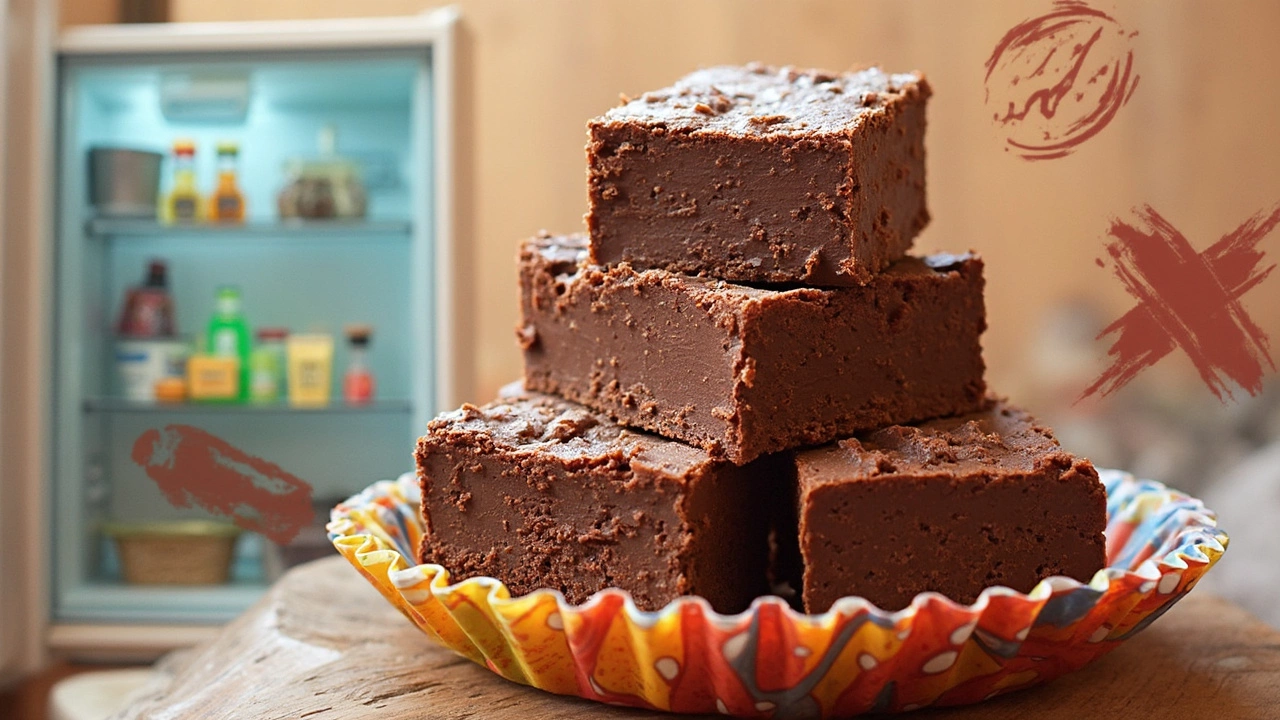
If you’ve ever popped fudge into the fridge thinking you’re keeping it fresh, join the club. It sounds logical, right? But the fridge is actually one of the worst spots to stash your homemade fudge. Cold air and moisture ruin what you spend all that time making—unless you like rock-hard fudge or grainy sugar crystals, which honestly, nobody does.
Here’s why: fudge has a delicate balance of sugar, fat, and a tiny bit of moisture. The fridge messes with this mix. Instead of a smooth, super creamy square, you get something crumbly or sticky, depending on how the sugar reacts to the cold. Have you ever bitten into fudge that felt more like a toffee brick? Yep, blame the fridge.
But don’t worry, keeping fudge at its best is easier than you’d think—and it doesn’t involve reorganizing your whole kitchen. Coming up: the science behind fudge’s meltdown, why room temperature wins, and simple tricks to rescue fudge if you accidentally went for the cold route. If Smokey (my cat) could talk, I’m pretty sure he’d say good fudge belongs on the counter, not next to last night’s leftovers.
- How the Fridge Changes Fudge
- What Happens to Texture and Flavor
- Better Ways to Store Fudge
- Common Mistakes and Quick Fixes
How the Fridge Changes Fudge
So, what’s the problem with sticking your fudge storage in the fridge? It boils down to science. Fudge stays good at room temperature because sugar and dairy work together to trap just the right amount of moisture. When you cool fudge too much, the sugar reacts and starts pulling moisture from the air. That often means your once-smooth fudge goes grainy, especially if you don’t keep it tightly wrapped. The fridge isn’t exactly low on humidity either—every time you open the door, you let in more damp air, making things worse.
Another weird thing happens when you chill fudge: the fats from the butter or chocolate inside separate out. So instead of that rich, melt-in-your-mouth texture you expect, you end up with fudge that feels dry or oddly greasy. Not exactly a win if you ask me. Even big chocolate brands warn against cooling their fudge, pointing out that sudden cold temps mess with taste and texture.
If you’ve ever noticed white streaks or spots on refrigerated fudge, that’s called "sugar bloom." It looks a bit like mold, but it’s just sugar crystals coming to the surface. Although it won’t hurt you, it definitely ruins the look—and let’s be real, nobody wants to eat spotted fudge at a party!
To sum it up, here’s what the fridge actually does to fudge:
- Makes it go hard and tough, not creamy
- Turns the texture gritty or sandy
- Causes unwanted white "sugar bloom" on top
- Can suck out or add weird moisture, so pieces get sticky or overly dry
Bottom line: the fridge just isn’t fudge-friendly unless you like your sweet treat as a science experiment gone wrong. Lucky for us, there are much better ways to store fudge that keep every square just as you made it.
What Happens to Texture and Flavor
Sticking fudge in the fridge seems harmless, but here’s what actually goes down: the cold alters the sugar structure, so that smooth bite you expect turns gritty. The chill basically causes sugar to re-crystallize faster. Suddenly, instead of melt-in-your-mouth fudge, you’ve got crumbly cubes that feel off. And if you’ve ever noticed the surface of fudge looking dull or even weepy, blame condensation—fridges are full of hidden moisture that messes with the top layer and even makes it sticky at times.
The fridge also does a number on your fudge’s flavor. Chocolate, nuts, and even vanilla can soak up the odors of leftovers sitting nearby. So if your fudge suddenly tastes a bit like last night’s onion pasta, you know why. Plus, fat dulls as it gets cold, muting flavors that normally pop at room temperature.
Here’s a quick breakdown of how storage methods mess with fudge:
| Storage Method | Texture Result | Flavor Result |
|---|---|---|
| Fridge (in airtight container) | Hard, grainy, or sticky | Absorbs fridge smells, less flavor |
| Room Temp (airtight container, dark place) | Soft, creamy, holds structure | Full, rich taste stays true |
| Freezer (well-wrapped) | Firm but can dry out, needs thawing | Slight loss of flavor, safe for longer term |
Why is this a thing? Well, fudge needs a controlled amount of humidity and stable temperature to stay creamy. The fridge swings both in the wrong direction—too cold and too damp. Sure, the fudge storage debate still pops up online, but candy experts are clear: room temperature wins every time if you want your fudge tasting like it just came off grandma’s stove.
Bottom line: if you store your fudge in the fridge, don’t expect it to stay perfect. You risk a weird bite and muted taste, which really just wastes good ingredients. Keep it sealed, cool, and away from kitchen drama and those sugar crystals and rich flavors will stick around like old friends.

Better Ways to Store Fudge
Room temperature is hands-down the best spot to keep fudge at its peak. Forget the fridge—unless it’s a scorching summer day with no air conditioning. The trick is to control moisture and air, because both can mess with the texture. Fudge loves a cool, dry, dark spot. Think pantry shelf or a kitchen cabinet away from the stove or dishwasher steam.
Use an airtight container for storage. This blocks air and keeps the fudge from drying out or soaking up weird smells from other stuff in the kitchen. If you’re stacking more than one layer of fudge in the container, put a piece of parchment or wax paper between layers so the pieces don’t stick together.
"Fudge is best kept at room temperature, in an airtight container, and will last up to two weeks this way with no loss of quality," says the editors of Cook’s Illustrated.
Want to go the extra mile? Wrap each square or slab tightly in plastic wrap before putting it in the container. No airflow means no dry edges or sugar crystals forming. If you need to store fudge longer—like you made a mega batch for the holidays—freezing works better than the fridge. Wrap the fudge well in plastic and then in foil, then pop it in a freezer-safe bag. Thaw it at room temperature, unopened, to avoid condensation making the fudge sticky.
- fudge storage: Room temp, airtight container for up to 2 weeks
- For longer: Freeze, but never chill in the fridge
- Always layer with parchment/wax paper to stop sticking
- Hot kitchen? Try a basement or any steady, cool spot (ideally around 65-70°F / 18-21°C)
Here’s a quick look at how long fudge lasts in different storage situations:
| Storage Method | Best Quality Lasts |
|---|---|
| Room Temperature (Airtight) | 1-2 weeks |
| Freezer (Well-Wrapped) | 3 months |
| Fridge (Not recommended) | 1 week (texture suffers) |
If you’re like me and live with a sneaky pet (shoutout to Smokey) or kids, store fudge up high and keep the container sealed. Nobody wants cat hair or curious fingers in their chocolate fix.
Common Mistakes and Quick Fixes
The classic fudge mistake? Tossing it straight in the fridge thinking it’ll magically last longer. The truth: the cold, damp air from the fridge draws moisture to the surface and messes with the sugar structure. This leads to that gritty texture or makes the fudge dry and crumbly instead of soft and smooth. And don’t even get me started on storing uncovered fudge—it turns into a hard brick no one wants to eat.
Let’s look at what usually goes wrong and easy ways to fix it:
- Problem: Fudge gets hard and dry after fridge storage.
Fix: Let the fudge sit at room temp in an airtight container for a few hours. Sometimes, it softens up on its own. If not, wrap each piece in plastic wrap and add a slice of fresh bread to the container—the fudge soaks up the moisture and softens by the next day (just toss the bread later). - Problem: Fudge turns grainy or develops sugar crystals.
Fix: This usually happens if fudge cools too quickly in the fridge. Next time, cool your fudge in the pan at room temp before slicing. If your current batch is grainy, gently microwave pieces in short bursts—10 seconds at a time—to help melt and reset the sugar. - Problem: Fudge absorbs weird fridge smells.
Fix: Fudge is like a sponge for odors. Always store it tightly sealed, but if it already smells odd, try airing it out at room temp. If the flavor is ruined, chocolate dips or chopping it up for brownies might save the day. - Problem: Fudge dries out when left uncovered.
Fix: Always wrap fudge well—plastic wrap, wax paper, or a tight tin work best. For an extra moisture shield, double-wrap and pop it in a resealable bag.
Here’s a quick cheat sheet for how long fudge lasts in different conditions. (And honestly, you’ll probably eat it all before it ever goes bad!)
| Storage Method | Texture | How Long It Lasts |
|---|---|---|
| Room Temp (airtight) | Soft, creamy | 1-2 weeks |
| Fridge (airtight) | Can get hard/dry | 3-4 weeks |
| Freezer (well-wrapped) | Best thawed slowly | 2-3 months |
For the best fudge storage, stash your treats in an airtight container, somewhere cool and out of the sun. And if you get it wrong, these fixes usually save the day. Worst case? Just call it rustic fudge and enjoy with some coffee. Mistakes and all, fudge is still fudge!